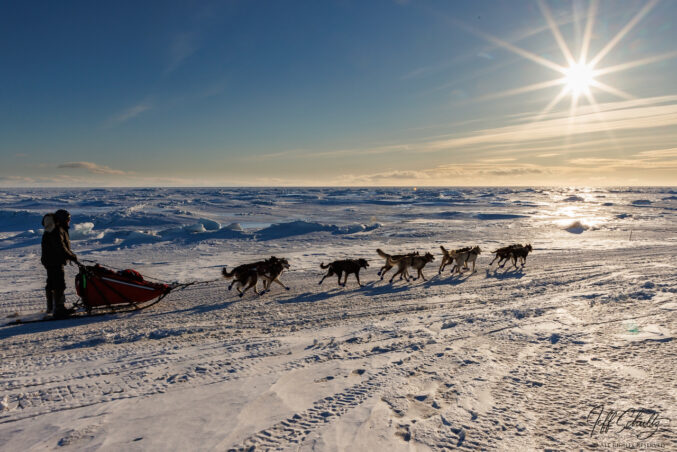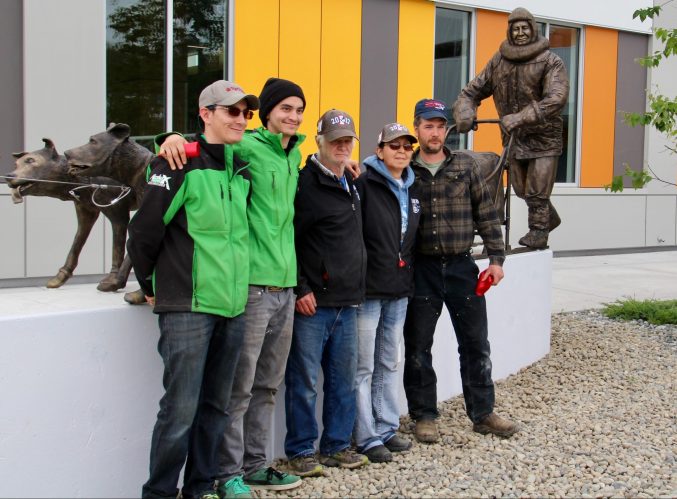
Get in the spirit with an Iditarod Tree decorated with miniature booties and tags with checkpoint details, musher ornaments and information, and snowflakes. Photo Credit: Iditarod
I’ve been wrapping presents this week and, as a busy mom, that sometimes includes wrapping my own gifts. While sorting and organizing it became clear that the theme of my holiday is “winter weather gear.” I wrapped, and will unwrap, liner gloves, Smartwool socks, three sets of base layer long underwear, two mid layer wool shirts, mukluks, and a snow skirt (so I can be stylish and sassy while staying warm and snug). As I took in my pile, giddy with excitement for my upcoming trip to the 2023 Iditarod, I realized that what I was looking at is actually a barrier to entry. Having the right clothing to travel to the remote areas of Alaska in the winter isn’t cheap, and it is a luxury to be able to purchase these items to guarantee I have a safe and successful trip.
“Barrier to Entry” is a term that originated in the economics/finance world and refers to the inability of new businesses/products to compete with established industries. Over time the phrase has been adapted to mean something that prevents a person from entering a new sphere with already established members and criteria. Some barriers are due to exposure – not knowing where or how to try a new sport like dog mushing. Some are educational -not knowing the language of the area you’re visiting prevents a full understanding of the culture. Some are financial – the cost of skiing or hockey in Western, NY where I live is significantly higher than basketball or track. Dog sled mushing, and Iditarod in particular, has all types of barriers; but it also provides numerous examples of how these barriers can be overcome.

Musher Meredith Mapes shows off the extensive gear needed to race! Photo Credit: Terrie Hanke
A major barrier for students is lack of exposure to cultures, activities, and lifestyles outside of their community. Expanding exposure opens up the world to curious learners. Good news, teachers! You are already doing this by integrating Iditarod into your classrooms. Thanks to you, students from New Mexico to North Dakota are learning about dog sled mushing through IditarodEDU. The exposure doesn’t end there. Through Iditarod, students can see the potential for future careers as veterinarians, authors of children’s books, or as a nature photographer like Jeff Schultz. Presenting the race in a historical or environmental context ignites a fire under those future researchers and historians, or climate change scientists.

Photographer Jeff Schultz captured this image of Jessie Holmes on the Bering Sea on the trail coming during the 50th running of the Iditarod Trail Sled Dog Race.
Copyright (C) Jeff Schultz/SchultzPhoto.com ALL RIGHTS RESERVED
Once students know about Iditarod, how do they get the education necessary to enter the world of dog sled mushing? This is a huge hurdle, but one I’ve learned takes two paths. First, there is the family path. Mushing runs in families. To learn more about the Iditarod Dynasties check out the IditarodEDU December Newsletter for Zuma’s Scavenger Hunt on Mushing Families. We know that our families introduce us to the activities they enjoy and share their love of sports teams or crafts with us as we grow. That is why there are so many multi-generational mushing families. Parents teach their children what they love to do. I start there. Students love to share that they play lacrosse because mom played in high school, they crochet because grandma taught them, or they like to cook with dad (because he makes the best spaghetti EVER – do not dispute the student on this one, you’ll only lose). Students are able to make the connection that the things we learn from our elders are valuable and key components of our identity.

The Redingtons- a family of mushers! Photo Credit: Terrie Hanke
A bronze cast of Joe Redington, Sr., was dedicated at Joe Redington Jr. Sr. High School in June, 2017.

Susan Butcher Posing w/Lead Dog Granite Finish Line Nome. Musher and mentor! Photo Credit: Iditarod
If dog sledding isn’t part of your students’ cultural heritage, which it likely is not, how would you learn to race? Musher Brent Sass recalls “I had big dreams. When I was eight years old I said, I’m going to Alaska. That was my goal. I didn’t know anything [about dog sledding]. But I knew that I wanted to be with those big mountains, in those big rivers, and all that wilderness, and I never let that dream go.” Someone, likely a teacher, exposed him to the natural beauty of Alaska. He knew nothing about mushing, but once in Alaska he saw a neighbor running a team of sled dogs and he was ready to learn. Sass developed a great relationship with 4-time Iditarod Champion Susan Butcher; he learned from the best. Sass knows It isn’t easy to work your way up, and achieving this lifestyle requires a “burning passion” and “a good work ethic.” Learning is challenging, but also rewarding. 2012 Junior Iditarod Champion, and 2-time Iditarod finisher Noah Pereira started local in Brockport, NY, but forged a relationship with Dallas Seavey, of the multi-generational mushing knowledge Seaveys, to help guide him. Part of getting into something new is finding the right teacher, coach, or guide.
Dog mushing is expensive; the gear, the dogs, the vet care, the food and snacks, the musher clothing…the list goes on and on. The financial barriers to this sport are very real. Many mushers get their start as handlers, working for established mushers. This provides experience and the opportunity to mush without having to own their own team. Earlier this month Brent Sass’ handler Claire Smeaton ran a team of his dogs at the Alpine Creek Excursion Sled Dog Race. Students can find ways to get around financial barriers if they are creative and flexible; used equipment and second-hand gear can provide entry to a new sport.

Handlers practice running with a team. Will they lead one as mushers someday? Photo Credit: Iditarod
Students looking to become Iditarod mushers, especially those not from Alaska, will face some challenges, but these hurdles are not insurmountable. Breaking down the barriers to entry – for any activity – requires our students to have a grasp on social-emotional skills like perseverance, commitment, dedication, and determination. They’ll need confidence to throw themselves into an unfamiliar arena, humility to learn from their mistakes, and a willingness to learn from others. They will need to forge connections and create friendships, prove themselves with hard work and a positive attitude. These are the skills that will break down barriers, and the skills we need to teach alongside academic content, because every child deserves to achieve their dream and nothing should stand in their way.

Living out her mushing dream – 2022 Jr. Iditarod champ, Emily Robinson. Photo Credit: Jim Deprez
Library Learnings: The picture book The Magical Yet by Angela DiTerlizzi is a great story to cover this topic. The main character feels like she’ll never ride a bike and is ready to give up, until she meets the magical yet – because working towards a goal will take time, patience, and determination. You might not be a dog sled musher (or astronaut, chef, or musician)…yet, but that doesn’t mean you can’t get there! Breaking down barriers can be hard, but if we arm our students with the SEL skills to persevere, anything is possible!


